Description
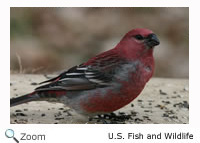 The pine grosbeak is 9-10 inches in length with a wingspan of 12-13 inches. It is a sturdy bird with a strong, short, cone-shaped bill; a long, slightly forked tail; and dark brown wings with white bars. The male has a rose-red head, breast, and back. The female has a yellowish-brown head and a gray breast and belly. The pine grosbeak is 9-10 inches in length with a wingspan of 12-13 inches. It is a sturdy bird with a strong, short, cone-shaped bill; a long, slightly forked tail; and dark brown wings with white bars. The male has a rose-red head, breast, and back. The female has a yellowish-brown head and a gray breast and belly.
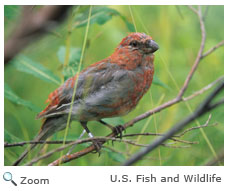 Male and female immature pine grosbeak can be hard to tell apart by sight until their second year. In his second year, the male pine grosbeak molts and grows new red feathers. Male and female immature pine grosbeak can be hard to tell apart by sight until their second year. In his second year, the male pine grosbeak molts and grows new red feathers.
Range  The pine grosbeak breeds from Alaska east to Nova Scotia and northern Maine and in the coniferous forests in the mountains of the Western United States. It winters in its breeding range south into the northern United States, including New Hampshire. The pine grosbeak breeds from Alaska east to Nova Scotia and northern Maine and in the coniferous forests in the mountains of the Western United States. It winters in its breeding range south into the northern United States, including New Hampshire.
|
|
Habitat
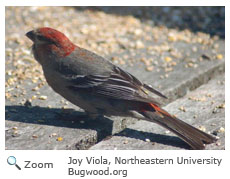 The pine grosbeak breeds in coniferous forests. It winters in coniferous, deciduous, mixed forests and other areas where it can find food, including cities and suburban areas. The pine grosbeak breeds in coniferous forests. It winters in coniferous, deciduous, mixed forests and other areas where it can find food, including cities and suburban areas.
Diet
Most of the pine grosbeak's diet is made up of seeds, buds, and fruits, but it also occasionally eats insects.
Life Cycle
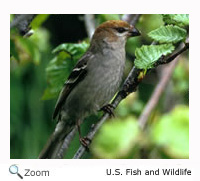 The female pine grosbeak lays 3-4 eggs in a twig nest lined with lichen, moss, and grass. The nest is built close to the ground. The female incubates the eggs for 13-14 days. The male brings the female food while she is incubating the eggs. Both the male and the female feed the chicks. The chicks fledge when they are about two weeks old, but they may still be fed by their parents after they fledge. The female pine grosbeak lays 3-4 eggs in a twig nest lined with lichen, moss, and grass. The nest is built close to the ground. The female incubates the eggs for 13-14 days. The male brings the female food while she is incubating the eggs. Both the male and the female feed the chicks. The chicks fledge when they are about two weeks old, but they may still be fed by their parents after they fledge.
Behavior
During the breeding season, pine grosbeaks are usually found in pairs. In the winter, they gather in flocks to forage for food. They are somewhat nomadic and move from place to place in search of food.
|

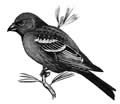


 The pine grosbeak breeds from Alaska east to Nova Scotia and northern Maine and in the coniferous forests in the mountains of the Western United States. It winters in its breeding range south into the northern United States, including New Hampshire.
The pine grosbeak breeds from Alaska east to Nova Scotia and northern Maine and in the coniferous forests in the mountains of the Western United States. It winters in its breeding range south into the northern United States, including New Hampshire.

